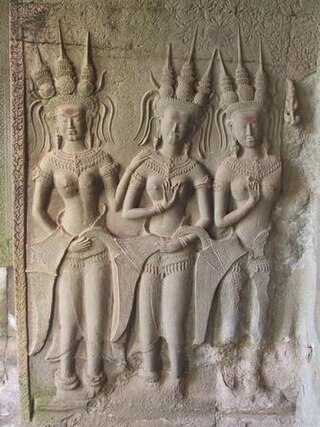
Temple dance denotes a religious performance held in the temples, such as sadir, prescribed by Agamas. Traces of these ancient temple dances of India are seen in Bharatanatyam and Odissi.
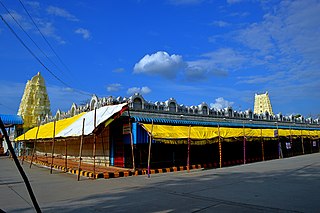
The Varasiddhi Vinayakar Temple in Besant Nagar, Chennai, India is a Hindu temple, located near the beach in Besant Nagar. It is dedicated to the Hindu god Vinayaka or Ganesha. The temple participates in activities such as feeding the poor and holds poojas frequently.

A Hindu temple, also known as Mandir, Devasthanam, or Koil, is a sacred place where Hindus worship and show their devotion to dieties through worship, sacrifice, and devotion. It is considered the house of the god to whom it is dedicated. The design, structure and symbolism of Hindu temples are deeply rooted in Vedic traditions, which use circles and squares in their architecture. The temple's design also represents the concept of recursion and the equivalence of the macrocosm and the microcosm through astronomical numbers and specific alignments related to the location of the temple and the connection between the deity and the worshipper. A temple incorporates all elements of the Hindu cosmos — presenting the good, the evil and the human, as well as the elements of the Hindu sense of cyclic time and the essence of life — symbolically presenting dharma, artha, kama, moksha, and karma.
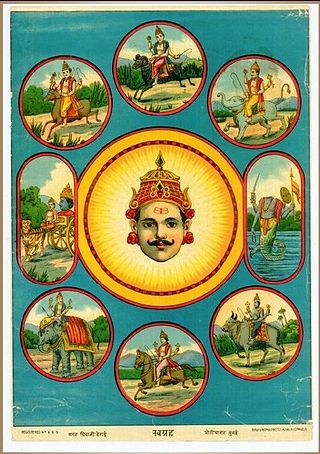
The navagraha are nine heavenly bodies and deities that influence human life on Earth according to Hinduism and Hindu astrology. The term is derived from nava and graha. The nine parts of the navagraha are the Sun, Moon, planets Mercury, Venus, Mars, Jupiter, and Saturn, and the two nodes of the Moon.

Pūjari is a designation given to a Hindu temple priest who performs pūja. The word comes from the Sanskrit word "पूजा" meaning worship. They are responsible for performing temple rituals, including pūjā and aarti. Pujari are mainly drawn from the Hindu Brahmin and Billava

Malibu Hindu Temple is a Hindu temple built in the traditional South Indian style, and dedicated to the worship of the Hindu god Venkateswara. It is located in the Santa Monica Mountains, in the city of Calabasas near Malibu, California.
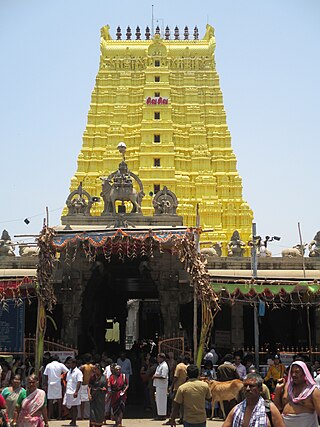
Ramanathaswamy Temple is a Hindu temple dedicated to the Hindu god Shiva located on Rameswaram island in the state of Tamil Nadu, India. It is also one of the twelve Jyotirlinga temples. It is one of the 275 Paadal Petra Sthalams, where Nayanars, Appar, Sundarar and Tirugnana Sambandar, have glorified the temple with their songs. The Lingam of Ramanathaswamy (Shiva), was established and worshiped by Shri Rama, before he crossed his bridge to the present-day island of Sri Lanka. It is one of the Char Dham pilgrimage sites. The temple was expanded during the 12th century by the Pandya Dynasty, and its principal shrine’s sanctum was renovated by Jeyaveera Cinkaiariyan and his successor Gunaveera Cinkaiariyan, monarchs of the Jaffna kingdom. The temple has the longest corridor among all Hindu temples in India. It was built by King Muthuramalinga Sethupathiy. The temple, located in Rameswaram, is considered a holy pilgrimage site for Shaivites, Vaishnavites and Smarthas.
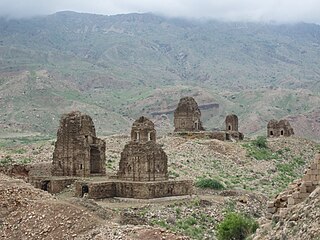
Kafir Kot or Kafirkot is an ancient Hindu temple complex in the Dera Ismail Khan district of the Khyber Pakhtunkhwa province of Pakistan. It consists of the ruins of five temples and a large fort. It was an ancient Hindu fort with a famous temple inside its walls. The Kafir Kot complex in Khyber Pakhtunkhwa is often referred to as the "northern Kafir Kot" to distinguish it from the "southern Kafir Kot" that is located in the town of Bilot Sharif, approximately 35 kilometres (22 mi) to the south.

The Shree Lakshmi Narayan Hindu Temple in Bradford, West Yorkshire is the largest Hindu temple (mandir) in Northern England. The temple was designed by local Yorkshire architects and built by a local construction company. The temple is faced with Yorkshire stone, and the design modern, reflecting the position of Hindus as part of contemporary Yorkshire society. The temple is unusual in housing most of the major deities revered by the Hindu community, in addition to Lakshmi Narayan, the main deities. This reflects the needs of the Hindu population in the United Kingdom, where temples have to serve all types of Hindus rather than just followers of a specific deity.

The Hindu Temple of Atlanta is located in Riverdale, Georgia, and serves the Metro Atlanta Hindu population. But, because of its proximity to the I-75, and its popularity, nearly 5-10% of the devotees are from the eastern seaboard, southern, and midwestern states. The temple is 9-miles away from the Hartsfield-Jackson International Airport terminal. It has been rated as one of the top 10 Hindu temples in the US.

Marayikkodu Sree Indilayappan Kshethram is a 1500-year-old Hindu temple in South India. Non-Hindus are permitted in the temple. It is in Karickom, 5 km from Kottarakara.

Vaikom Satyagraha, from 30 March 1924 to 23 November 1925, was a nonviolent agitation for access to the prohibited public environs of the Vaikom Temple in the Kingdom of Travancore. Kingdom of Travancore was known for its rigid and oppressive caste system. The campaign, led by Congress leaders T. K. Madhavan, K. Kelappan, K. P. Kesava Menon, George Joseph, E. V. Ramasamy "Periyar" and was noted for the active support and participation offered by different communities and a variety of activists.

The Hindu Temple of Delaware is a Hindu temple in Hockessin, Delaware. Inaugurated in 2002, it is the first Hindu temple constructed in Delaware. According to The News Journal, the temple has become "a social and cultural gathering place" for Indian Americans in New Castle County.

The Kottankulangara Festival or Chamayavilakku is an annual Hindu festival in Kerala, India in which thousands of male devotees dress-up as females and celebrate the festival.
Thaliyadichapuram Sree Mahadeva Temple is a Hindu temple located in Nemom, 7 km from Thiruvananthapuram, Kerala. The word 'Thali' refers to a Shiva temple; however, the temple complex also houses shrines of Lord Ganesh, Lord Ayyappa and Nagaraja.
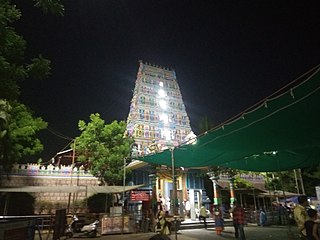
Sri Peddamma Thalli Temple or Peddamma Gudi is a Hindu temple located at Jubilee Hills in Hyderabad, Telangana, India. It is very famous during the festive season of Bonaalu.
The dhvajastambha (ध्वजस्तम्भ) refers to the flagstaff erected in front of the mukhamaṇḍapa of a Hindu temple. The dhvajastambha is usually built within the temple walls (prākāra). They are traditionally built of wood and stone, where the wooden variety is often finished with a metal covering (kavaca). The dhvajastambha is a common feature in South Indian temples.

Kattil Madam Temple is a dilapidated shrine in the Palakkad district in Kerala, India. It is thought to be a Jain temple built around the ninth or tenth centuries AD and is situated on the Pattambi Guruvayur road.

The Amb Temples, locally known as Amb Sharif, are part of an abandoned Hindu temple complex on the Sakesar mountain, located at the western edge of the Salt Range in Pakistan's Punjab province. Although foundations go back to the period of Kushan Empire, the temple complex was built in the 9th to 10th centuries CE during the reign of the Hindu Shahi empire.
Gnayiru, is a neighborhood in Tiruvallur district, located North of Chennai, a metropolitan city in Tamil Nadu, India.
















